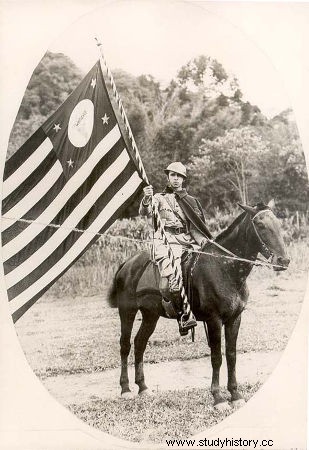
By Me. Cláudio Fernandes
With the so-called Revolution of 1930 , Getúlio Vargas , with the help of the military, became the leader of a “new republic” after the deposition of Washington Luís, the last of the representatives of the politics of the oligarchies, which characterized the Old Republic. The “mission” given to Vargas was to centralize political power, dismantling the political forces that maintain regional hegemonies. The state of São Paulo, one of the main granaries of political agents of the Old Republic, was one of the focuses of resistance to the Vargas government. The Revolution Constitutionalist from 1932 it was the height of the revolt against the federal government. That year, São Paulo became the scene of a war.
Many factors contributed to the Constitutionalist Revolution of 1932. The main one is related to the name that this revolution took with it, that is, since Vargas had assumed power, even no constitution had been drawn up to legitimize the “new republic”, and this was seen as a political outrage, not only in São Paulo, but also in other states. Furthermore, Vargas ruled in an authoritarian manner (although the “New State dictatorship” had not been installed at that time), appointing interventors for each state, as was the case with Pedro de Toledo, in São Paulo.
In São Paulo, many anti-government organizations began to articulate to take power by storm. The movement lieutenant was part of these organizations. One of the main ones was the Party Democratic. In other states, such as Rio Grande do Sul, organizations such as the Frente Única Gaúcha broke with Getúlio Vargas and became associated with the Paulistas. Military personnel from other regions, such as Minas Gerais, also did the same. The trigger for the unfolding of the conflict was the invasion of a tenentista newspaper in the city of São Paulo. Four young people were murdered on that occasion:Martins , Miragaia, Dráusio and Camargo. The abbreviations of their names were used in the formation of the groupingMMDC , one of many who joined the PD and the lieutenants.
On July 9, the uprising against the federal government began. The objective was to besiege the city of Rio de Janeiro and force Vargas to resign or capitulate, that is, to comply with the rebels' demands. However, the union of the forces of São Paulo with those of other states did not take place completely and the contingent of combatants ended up being much smaller than that of the government forces. There were about 18,000 government men against 8,500 revolutionaries. Furthermore, the federal government had heavy artillery and assistance from the navy and planes that bombed the capital of São Paulo.
It was almost three months of a conflict that was concentrated within the state of São Paulo. About the process of the conflict, says the historian Boris Fausto:
“[…] The attack on the territory of São Paulo was launched from the south of the state, from the border with Minas Gerais and the Vale do Paraíba. From mid-September onwards, the situation of the revolutionaries became increasingly precarious. The miners occupied Jundiaí and Itu and, in Vale do Paraíba, federal troops gained ground, between marches and counter-marchs. The threat of occupation of the city of São Paulo had become real. Finally, representatives of the São Paulo public force met on October 1, 1932 with General Góis Monteiro, at his headquarters in Cruzeiro, in Vale do Paraíba. The Public Force decided to surrender, in a gesture that spared lives and put an end to the last hopes of resistance.” [1]
Even having lost the war, the revolutionaries of 1932 ended up pressuring the federal government to draft a constituent in the following year, a fact that resulted in the writing of the 1934 Constitution.
NOTES
[1] FAUST, Boris. History of Brazil . São Paulo:EDUSP, 2013. p. 299.
